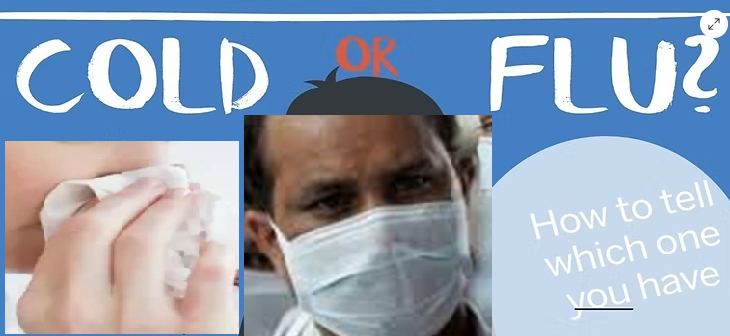FALL SEASON- IDENTIFY COMMON COLD & FLU-TAKE CARE OF HEALTH
- Prof. (Dr) Usha

- Oct 11, 2020
- 4 min read
Updated: Apr 25, 2025
While you can get the flu at any time during the year, the fall officially marks the beginning of the flu season in Canada. Usually the cases of the flu start to rise in October, peak between December and February months, and usually goes down around May. As per IPAC (Infection Prevention & Control) Canada influenza resources, in Canada, as of Aug 2020 there have been 42,541 confirmed cases of Influenza. To date there have been 24,347 cases of Influenza A and 18,194 cases of Influenza B. Influenza is a respiratory infection caused by influenza viruses of the family Orthomyxoviridae. There are 3 types of influenza viruses, called influenza A, influenza B and influenza C. Influenza A and B are associated with seasonal influenza and most outbreaks and epidemics of influenza. Influenza C is relatively rare and does not usually cause epidemics or outbreaks. Health-care workers have already been working on the front lines for several months and are now bracing for a possible spike in cases of hospitalizations, prompting concerns about potential rundown and other problems. We know the growing corona cases are also rising concern for all of us in Ontario.
Healthcare officials are also planning for a "reasonable worst-case scenario," where a fall spike in infection cases is followed by ongoing highs and lows that put excessive demands on our health care system. The fall rise in cases coincides with the flu and cold season, potentially putting added strains on hospitals and other health resources.
As per the health reports, the death rate for influenza in Canada is generally 500 to 1500 cases per year. The combined, influenza and pneumonia which is a common complication of influenza, kills more than 8,000 people a year. In some people, especially young children and those over 65 years of age or people with other systemic illnesses such as heart disease, diabetes, cancer, respiratory illnesses influenza can be very severe, requiring hospitalization. Health authorities suggest the people with such risk factors should receive immunization against influenza each year.
Many people fall sick during Fall season. Changing weather also plays a role here. Looking at the gravity of the situation, it is important to identify and recognize if your symptoms indicate the flu or a simple common cold? Flu and the common cold are both respiratory illnesses, but they are caused by different viruses. Since these two types of illnesses have similar symptoms, it can be difficult to easily differentiate between them based on symptoms alone. As they can manifest themselves in similar ways, it can be hard to know which ailment the sufferer has.
There are a few distinct differences between a common cold and the flu, though. In general, flu is worse than the common cold, and symptoms are more intense. Common cold is usually milder than flu. While you can have a fever, cough, sneezing, congestion and a sore throat with both, the symptoms tend to be more severe and intense when you have the flu and symptoms usually come on more quickly.
People with common cold are more likely to have a runny nose, whereas those with the flu are more inclined to experience chills as well as serious muscle and body aches. With the flu, you can typically experience more of the symptoms, not simply one or two. People with the flu may experience a tough time even getting out of bed; compare to that, those with a cold may still feel well enough to go to their work. Special tests that usually must be done within the first few days of illness can tell if a person has the flu.
Flu vs. common cold
The symptoms of the flu and the common cold can be very similar but, unlike a case of the common cold, the flu can lead to serious health problems like pneumonia.
Following symptoms can help you distinguish common cold from the flu.
What should you do If you get the flu?
Be sure to:
Stay home and get plenty of rest
Drink lots of fluids and avoid caffeine, alcohol and tobacco
Take care of your cough
Run the humidifier if needed
Treat muscle pain using a hot water bottle/heating pad or take a warm bath
Gargle with a glass of warm salt water
Suck on hard candy or lozenges and keep the throat moist
Use spray or saline drops for a stuffy nose
Speak to your doctor/ nurse practitioner or pharmacist about over-the-counter (OTC)medications that can help you feel better such as basic pain or fever relievers.
Immediately consult your doctor/nurse practitioner if:
You don't start to feel better after a few days
Your symptoms get worse
You’re pregnant
You have shortness of breath or difficulty breathing
You feel pain or pressure in your chest or abdomen
You vomit too often
Your symptoms get better once and then come back worse
Residents of long-term care facilities/nursing homes with persistent symptoms
People with weakened immune systems due to conditions such as HIV/cancer
You are in a high-risk group such as with medical conditions including cancer or diseases related to heart, lung, liver etc. and develop flu symptoms
IM Injection program and Injection Technique Certificate programs-1 day/2 days/3-5 days- training/ certification/ workshops at Springfield College helps prepare you get skills needed for a challenging career in physician’s offices, hospitals or medical clinics. Students learn details and techniques of SC, ID, IM, Depot injections, various vaccines for children and adults, safe and effective Injection techniques, patient communication and preparations in healthcare.
For details of IM Injection training program and Injection Technique Certificate programs and the best training-
CONTACT:
SPRINGFIELD COLLEGE OF HEALTH CARE, MANAGEMENT & TECHNOLOGY
Health Care Department
Bartley’s Square
1- Bartley Bull Parkway, Suite # 19,
(Oppo. Shoppers World Brampton, Above Food Basics)
Brampton, ON, L6W 3T7
Tel: 905-216-1600
E-Mail: info@ springfieldcollege.ca; admin@ springfieldcollege.ca




Comments